- The following is a
lesson/warning
in
getting the model RIGHT
- Consider the following
description
of a simple
supplier/project/part database:
- A construction company
performs a number of
construction projects
- A project
has name, duration, budget and uses
parts supplied by
some supplier.
- A part has name, weight and color
- A supplier has name, address, phone number
- A construction company
performs a number of
construction projects
- Projects
- Supplier
- Part
- Consider the following
two
ER-diagrams:
Model 1:
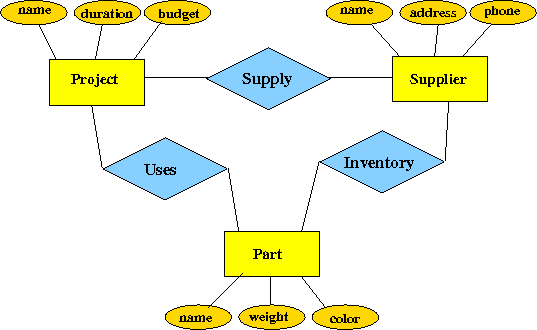
Model 2:
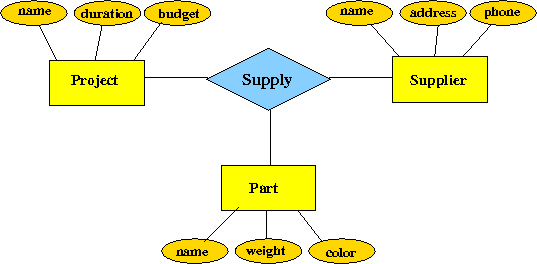
- Questions:
- Which model
will
capture
the above description ?
- Are these two models
equivalent (= same) ???
- If not, what does each model represent ?
- Which model
will
capture
the above description ?
- To answer the above question, consider the representation of
the following facts:
- Supplier s1 suppliers part p1 to project pj1
- Supplier s1 suppliers part p2 to project pj2
- Supplier s2 suppliers part p1 to project pj2
- Supplier s2 suppliers part p2 to project pj1
In Model 1, we will have the following entity instances:
Supplier Part Project ------------- ------------- ------------- s1 p1 pj1 s2 p2 pj2and the following relationship instances:
Supply Uses Inventory ---------------- ---------------- --------------- (s1, pj1) (pj1, p1) (s1, p1) (s1, pj2) (pj1, p2) (s1, p2) (s2, pj1) (pj2, p1) (s2, p1) (s2, pj2) (pj2, p2) (s2, p2) - Schematically:

In Model 2, we will have the same entity instances:
Supplier Part Project ------------- ------------- ------------- s1 p1 pj1 s2 p2 pj2But the relationship instances are different:
Supply -------------------- (s1, p1, pj1) (s1, p2, pj2) (s2, p1, pj2) (s2, p2, pj1) - Schematically:
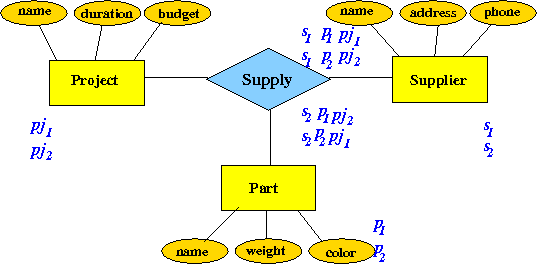
- The Difference in the models
- The "Supply" relationship in
Model 1
represents the fact that
"a (specific) supplier is
supplying ("has")
to a (specific) project" (with any part):

- The "Supply" relationship in
Model 2
represents the fact that:
a (specific) suppliers is
supplying
a (specific) part
to a
(specific) project":

This model captures the above description !!!
- The "Supply" relationship in
Model 1
represents the fact that
"a (specific) supplier is
supplying ("has")
to a (specific) project" (with any part):
- Which model
you need to
use
depends
on
what
you want to
represent !!!
But DO be aware that "drawing an extra line" in a ER-diagram has profound consequences....
- Power of a
model (= representation):
- A model is used to
represent
information on the
reality
- A model (= representation) is more powerful if it can store more items of information
- A model is used to
represent
information on the
reality
- Fact:
- A ternary relationship
can store more
information items
than any (fixed) number
of binary relationships
Explanation:
- Suppose there are
N entity instances stored in
each of the
entity types
supplier, part and project:

- The maximum number of
information items stored in
the binary relationship
Supply
between Supplier and Project is
N2:
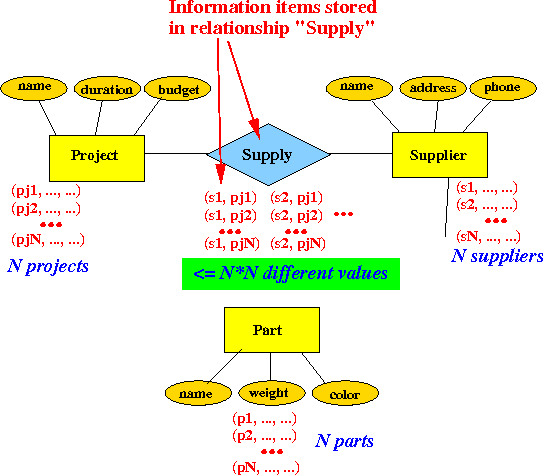
This is also true for the other 2 binary relationships.
Therefore, the maximum number of information items stored this model:

is at most 3 × N2
- On the other hand,
the maximum number of
information items stored in
the ternary relationship
Supply
between Supplier, Part and Project is
N3:
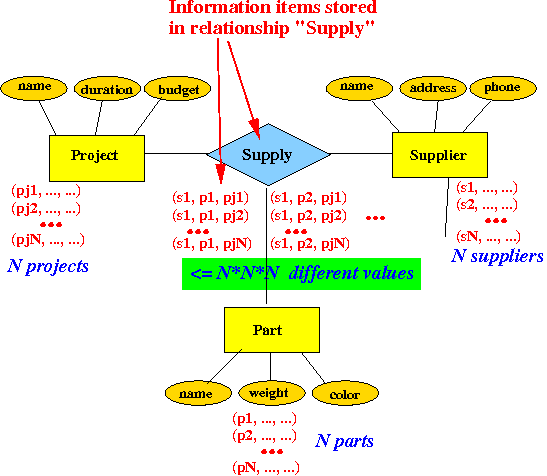
Since N3 > 3 × N2, one ternary relationship can store more information items than any (fixed) number of binary relationships
- Suppose there are
N entity instances stored in
each of the
entity types
supplier, part and project:
- A ternary relationship
can store more
information items
than any (fixed) number
of binary relationships
- Suppose we want
to store information on:
- Which supplier can supply which part
- Which part is used in which project
- Which supplier supplies to which project
we should use the following ER-model to represent the information:

Reason:
- The content
of relationships provide
ready information to
answers of
questions such as:
- How many different parts
does supplier s1 have in his
inventory
(Look in the Inventory relationship and count the number of occurences of s1)
- How many different parts
does supplier s1 have in his
inventory
- On the other hand,
answering
- How many different parts does supplier s1 have in his inventory
is more complicated using the ternary relationship:

You must remove duplicated facts when you count !!!
(E.g.: (s1, p1, pj1) and (s1, p1, pj2) says the same thing with regard to the posed query: that supplier s1 has p1 in his/her inventory)
- Which model you use
depends
on what information you
need to
store
- Always use the most suitable model (which may not be the most powerful model !!!)